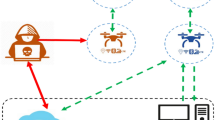Abstract
Along with the importance of safety, an IDS has become a significant task in the real world. Prior studies proposed various intrusion detection models for the UAV. Past rule-based approaches provided a concrete baseline IDS model, and the machine learning-based method achieved a precise intrusion detection performance on the UAV with supervised learning models. However, previous methods have room for improvement to be implemented in the real world. Prior methods required a large labeling effort on the dataset, and the model could not identify attacks that were not trained before.
To jump over these hurdles, we propose an IDS with unsupervised learning. As unsupervised learning does not require labeling, our model let the practitioner not to label every type of attack from the flight data. Moreover, the model can identify an abnormal status of the UAV regardless of the type of attack. We trained an autoencoder with the benign flight data only and checked the model provides a different reconstruction loss at the benign flight and the flight under attack. We discovered that the model produces much higher reconstruction loss with the flight under attack than the benign flight; thus, this reconstruction loss can be utilized to recognize an intrusion to the UAV. With consideration of the computation overhead and the detection performance in the wild, we expect our model can be a concrete and practical baseline IDS on the UAV.
Access this chapter
Tax calculation will be finalised at checkout
Purchases are for personal use only
Similar content being viewed by others
References
Agarap, A.F.: Deep learning using rectified linear units (relu) (2018). arXiv preprint arXiv:1803.08375
Arthur, M.P.: Detecting signal spoofing and jamming attacks in UAV networks using a lightweight ids. In: 2019 International Conference on Computer, Information and Telecommunication Systems (CITS), pp. 1–5. IEEE (2019)
Biermann, E., Cloete, E., Venter, L.M.: A comparison of intrusion detection systems. Comput. Secur. 20(8), 676–683 (2001)
Cheng, Y., Wang, D., Zhou, P., Zhang, T.: A survey of model compression and acceleration for deep neural networks (2017). arXiv preprint arXiv:1710.09282
Choudhary, G., Sharma, V., You, I., Yim, K., Chen, R., Cho, J.H.: Intrusion detection systems for networked unmanned aerial vehicles: a survey. In: 2018 14th International Wireless Communications & Mobile Computing Conference (IWCMC), pp. 560–565. IEEE (2018)
Cortes, C., Mohri, M., Rostamizadeh, A.: L2 regularization for learning kernels (2012). arXiv preprint arXiv:1205.2653
El-Khatib, J.W.T.S.O.M.A.A.K.: Hitl UAV dos & gps spoofing attacks (mavlink) (2020). https://doi.org/10.21227/00dg-0d12
Mitchell, R., Chen, R.: Adaptive intrusion detection of malicious unmanned air vehicles using behavior rule specifications. IEEE Trans. Syst. Man Cybern. Syst. 44(5), 593–604 (2013)
Pajares, G.: Overview and current status of remote sensing applications based on unmanned aerial vehicles (uavs). Photogram. Eng. Remote Sens. 81(4), 281–330 (2015)
Panice, G., et al.: A SVM-based detection approach for GPS spoofing attacks to UAV. In: 2017 23rd International Conference on Automation and Computing (ICAC), pp. 1–11. IEEE (2017)
Schmidhuber, J.: Deep learning in neural networks: an overview. Neural Netw. 61, 85–117 (2015)
Sedjelmaci, H., Senouci, S.M., Ansari, N.: A hierarchical detection and response system to enhance security against lethal cyber-attacks in UAV networks. IEEE Trans. Syst. Man Cybern. Syst. 48(9), 1594–1606 (2017)
Tan, X., Su, S., Zuo, Z., Guo, X., Sun, X.: Intrusion detection of UAVs based on the deep belief network optimized by PSO. Sensors 19(24), 5529 (2019)
Zhang, R., Condomines, J.P., Chemali, R., Larrieu, N.: Network intrusion detection system for drone fleet using both spectral analysis and robust controller/observer (2018)
Zou, H., Hastie, T.: Regularization and variable selection via the elastic net. J. R. Stat. Soc. Series B (statistical methodology) 67(2), 301–320 (2005)
Acknowledgement
This work was supported by Institute of Information & communications Technology Planning & Evaluation (IITP) grant funded by the Korea government (MSIT) (No.2018-0-00232, Cloud-based IoT Threat Autonomic Analysis and Response Technology).
Author information
Authors and Affiliations
Corresponding author
Editor information
Editors and Affiliations
Rights and permissions
Copyright information
© 2020 Springer Nature Switzerland AG
About this paper
Cite this paper
Park, K.H., Park, E., Kim, H.K. (2020). Unsupervised Intrusion Detection System for Unmanned Aerial Vehicle with Less Labeling Effort. In: You, I. (eds) Information Security Applications. WISA 2020. Lecture Notes in Computer Science(), vol 12583. Springer, Cham. https://doi.org/10.1007/978-3-030-65299-9_4
Download citation
DOI: https://doi.org/10.1007/978-3-030-65299-9_4
Published:
Publisher Name: Springer, Cham
Print ISBN: 978-3-030-65298-2
Online ISBN: 978-3-030-65299-9
eBook Packages: Computer ScienceComputer Science (R0)




